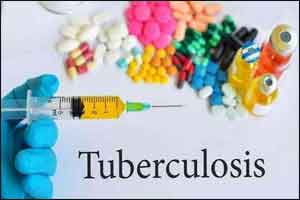- Home
- Editorial
- News
- Practice Guidelines
- Anesthesiology Guidelines
- Cancer Guidelines
- Cardiac Sciences Guidelines
- Critical Care Guidelines
- Dentistry Guidelines
- Dermatology Guidelines
- Diabetes and Endo Guidelines
- Diagnostics Guidelines
- ENT Guidelines
- Featured Practice Guidelines
- Gastroenterology Guidelines
- Geriatrics Guidelines
- Medicine Guidelines
- Nephrology Guidelines
- Neurosciences Guidelines
- Obs and Gynae Guidelines
- Ophthalmology Guidelines
- Orthopaedics Guidelines
- Paediatrics Guidelines
- Psychiatry Guidelines
- Pulmonology Guidelines
- Radiology Guidelines
- Surgery Guidelines
- Urology Guidelines
New antibiotic kills tuberculosis bacteria inside macrophages

A new of its kind study published in the journal ACS Infectious Diseases reports a new antibiotic that can find and kill tuberculosis bacteria where they hide.
Mycobacterium tuberculosis, the bacteria causing tuberculosis hide from antibiotics inside the very immune cells that are supposed to kill them, making treatment long and difficult. These bacterias allow themselves to be eaten by macrophage immune cells and then grow inside them, which becomes very hard to treat.
As a result, people infected with tuberculosis generally have to take antibiotics over many months, because the bacteria are only susceptible to the drugs when they break out of the macrophage in which they were born and search out a new one to invade.
Taking this unique lifestyle of the bacteria into account, researchers from the Indian Institute of Science, the Max Planck Institute, and MIT, decided to make an antibiotic that could make its way into the macrophages and hit the Mycobacteria where they hide.
Read also: New urine test quickly detects tuberculosis in HIV-positive patients
The investigators have previously worked with antibiotics produced by fish, sea squirts, and other sea creatures. Many of these sea creatures make antibiotic peptides - small pieces of protein-like material - with a special chemical talent: when they bind to copper atoms, they enable the copper to shift its electrical charge from +2 to +3 and back. Copper with this ability becomes aggressive, ripping electrons away from some molecules and adding them to others, particularly oxygen-containing molecules. The oxygen-containing molecules become free radicals, dangerous chemicals that attack anything they encounter, including Mycobacteria.
Human macrophages infected with Mycobacteria also use copper to attack the bacteria, but they do so in a less sophisticated way. They trap the bacteria in a bubble and then inject copper +1 ions into the bubble. But the Mycobacteria can handle that. To them, the bubble is a safe haven, and the Cu+ ions are mere annoyances. The bacteria can steal an extra electron from the Cu+ to make it Cu2+. The copper becomes unreactive and safe that way. And when enough Cu2+ surrounds the Mycobacteria, other, more dangerous kinds of copper can't get close.
Surrounded by defanged copper, "the bacteria can grow in peace. It's elegant!" say the authors. But if the investigators have their way, the copper camouflage will become Mycobacteria's downfall. If the antibiotic peptides can get close to the bacteria, they can grab onto one of the copper ions and weaponize it. The trick is getting the peptide close to the bacteria.
To do that, the chemists put the peptides into little bubbles similar to the kind cells use to move around packets of protein ingredients and other tasty stuff. When the bacteria snag one for a snack, the peptide works its chemistry and kills it.
The antibiotic peptide developed by the researchers effectively kills Mycobacteria living in macrophages in the lab, but they haven't been able to cure tuberculosis in mice yet - peptide drugs have various problems that make them tricky to use in mammals. The next step in the research is to use the same chemistry in smaller molecules that can be taken as pills like more typical antibiotics.
Tuberculosis is the number one cause of death from infectious disease worldwide. About 25 percent of people are currently infected globally. Most of those infections will stay dormant, but one in 10 will become active, infectious, and often fatal if untreated.
For reference log on to http://dx.doi.org/10.1021/acsinfecdis.8b00171

Disclaimer: This site is primarily intended for healthcare professionals. Any content/information on this website does not replace the advice of medical and/or health professionals and should not be construed as medical/diagnostic advice/endorsement or prescription. Use of this site is subject to our terms of use, privacy policy, advertisement policy. © 2020 Minerva Medical Treatment Pvt Ltd